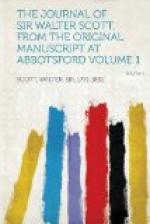“I need not say I have the greatest interest in the MS. which you mention. In case it shall really prove an authentic document, there would not be the least difficulty in getting the Bannatyne Club to take, perhaps, 100 copies, or obtaining support enough so as, at the least, to preclude the possibility of loss to the ingenious Messrs. Hay Allan. But I think it indispensable that the original MS. should be sent for a month or so to the Register House under the charge of the Deputy Register, Mr. Thomson, that its antiquity be closely scrutinised by competent persons. The art of imitating ancient writing has got to a considerable perfection, and it has been the bane of Scottish literature, and disgrace of her antiquities, that we have manifested an eager propensity to believe without inquiry and propagate the errors which we adopt too hastily ourselves. The general proposition that the Lowlanders ever wore plaids is difficult to swallow. They were of twenty different races, and almost all distinctly different from the Scots Irish, who are the proper Scots, from which the Royal Family are descended. For instance, there is scarce a great family in the Lowlands of Scotland that is not to be traced to the Normans, the proudest as well as most civilised race in the eleventh and twelfth centuries. Is it natural to think that holding the Scots in the contempt in which they did, they would have adopted their dress? If you will look at Bruce’s speech to David I., as the historian AElred tells the story, you will see he talks of the Scots as a British officer would do of Cherokees. Or take our country, the central and western part of the border: it was British, Welsh if you please, with the language and manners of that people who certainly wore no tartan. It is needless to prosecute this, though I could show, I think, that there is no period in Scottish History when the manners, language, or dress of the Highlanders were adopted in the Low Country. They brought them with them from Ireland, as you will see from the very curious prints in Derrick’s picture of Ireland, where you see the chiefs and followers of the wild Irish in the ordinary Highland dress, tempore Queen Elizabeth. Besides this, where has slept this universal custom that nowhere, unless in this MS., is it even heard of? Lesley knew it not, though the work had been in his possession, and his attention must have been called to it when writing concerning the three races of Scots—Highlanders, Lowlanders, and Bordermen, and treating of their dress in particular. Andrew Borde knows nothing of it, nor the Frenchman who published the geographical work from which Pinkerton copied the prints of the Highlander and Lowlander, the former in a frieze plaid or mantle, while the Lowlander struts away in a cloak and trunk hose, liker his neighbour the Fleming. I will not state other objections, though so many occur, that the authenticity of the MS. being proved, I would rather suppose the author had been some tartan-weaver zealous for his craft, who wished to extend the use of tartan over the whole kingdom. I have been told, and believe till now, that the use of tartan was never general in Scotland (Lowlands) until the Union, when the detestation of that measure led it to be adopted as the national colour, and the ladies all affected tartan screens or mantles.




